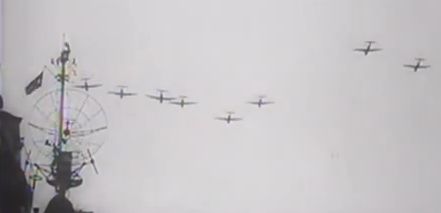|
|
|
|
|
Fratrie
|
||||||||||||||||||||||||||||||||||||||||||||||||||||||||||||||||||||||
| (pages liées) |
| Click HERE for Bob's role in WW2 |
Residence: Bridgewater, New Jersey.
Ed Loberg and I went thru flight training together in 1940 at the West Point of The Air: Randolph Field. We came together again in 1943 when he was called back from the South Pacific and I from Panama for the B-29 program. He became commanding officer of the 769 Sq, 34th BG and I was assigned to his unit. So he was my boss. At that time Col. Roush was operations officer of the 34 th group but later was shot down on the 2nd Ywatta mission and Ed recommended me to replace him so I became head of operations to the end of the war. I had many commanding officers but there were none better than Ed and he was one very skilled pilot. The only pilot to shoot down a Jap flying boat using a B-17 as a fighter plane.

I was air commander of the fly over [ndlr: and pilot of the lead plane]. Our target time was 9:17 am which we hit right on the head. I was warned by Gen. Ramey: "Vaucher, this is one target time you better not miss!" I had to assemble approx 500 B-29s and 150 Naval planes which stretched out for miles. I have been told that as the last signature was signed, Mac Arthur turned to his aide and said "Where are those *** planes?" but hardly had he finished that we started passing over.This news reel was of great interest to me as I have always wondered how we played into the ceremony. I have always said I flew 29 combat missions in B-29s and I just learned that the surrender mission was counted as a combat mission. So it turns out I flew on the first B-29 combat mission over Japan [Yawata, see Note below] and the last. In addition, I flew many, many more in B-18s, B-17, B-24, and Lb-30 in other theaters.
After the war, Bob turned down several opportunities to stay in aviation: either in the Air Force or with KLM in Singapore or as co-pilot with American Airlines. Rather he went into business, first landing a job in sales for the Palmer Marine Engine company, outselling everyone and becoming sales manager in 6 months. He then moved on to Niagara Machine and Tool and became VP of manufacturing and General Sales Manager. In 1960, he started his own machine tool business and finally retired in 1990.


Suzanne, David, Bob & Yvonne
In April 2010, Bob gave an address at the Flemington Tea Party Rally. Though he isn't really a Tea Party person, Bob is a great story-teller and he really enjoys sharing reminiscences about his early life on the Texas frontier and his later WW2 experiences. The talk was recorded on You Tube.
Note: B-29 raids on Japan (Wikipedia)
The plan, was to use B-29s to attack Japan from four forward bases in southern China, with five main bases in India. This operation was extremely costly, as all supplies had to be flown over the Himalayas ("The Hump") . The first B-29 flight over the The Hump took place on 24 April 1944. The first B-29 combat mission from India was flown on 5 June 1944, with 77 out of 98 B-29s bombing railroad shops in Bangkok. On 15 June 1944, the first raid from China took place. 47 B-29s launched from Chengdu, China, and bombed the Imperial Iron and Steel Works at Yawata, Japan. This was the first attack on Japanese islands since the Doolittle raid in April 1942. The first B-29 combat losses occurred during this raid, with one B-29 destroyed by Japanese fighters, one lost to anti-aircraft fire, and another disappeared over the Himalayas after takeoff from India. This raid nearly exhausted fuel stocks at the Chengdu B-29 bases, resulting in a slow-down of operations until the fuel stockpiles could be replenished. Later, Japan was bombed on: 7 July 1944 (14 B-29s), 29 July (70+), 10 August (24), 20 August (61), 8 September (90), 26 September (83), 25 October (59), 12 November (29), 21 November (61), 19 December (36) and for the last time on 6 January 1945 (49). The Japanese tactic of using aircraft to ram American B-29's was first recorded on the 20th August raid on the factories at Yawata. Sergeant Shigeo Nobe intentionally sliced his Kawasaki Ki-45 into a B-29 and several B-29s were to be destroyed in this way over the ensuing months. The term "Kamikaze" used to refer to these pilots was never, in fact, used by the Japanese military.
|